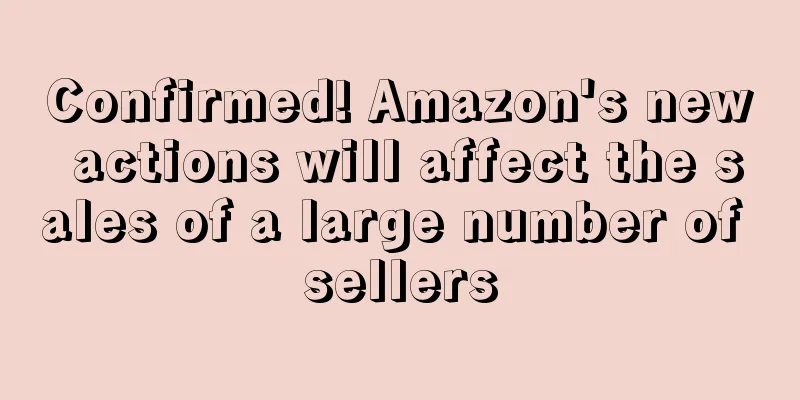Confirmed! Amazon's new actions will affect the sales of a large number of sellers

|
The "high return rate" label on Amazon's product detail page has sparked heated discussions, with sellers getting emotional: "If this label appears, it will greatly affect conversions and orders. In serious cases, it may even cause a link to be scrapped, which will invisibly exacerbate everyone's internal competition."
Without the knowledge of most sellers, Amazon has launched a “high return rate” label. The news has been officially confirmed in order to practice the customer-centric concept and encourage sellers to improve their services.
Official confirmation of the launch of the "High Return Rate" label
Recently, some Amazon sellers discovered that a "high return rate" label appeared on the product details page . The platform will automatically mark some products with excessively high return rates.
There is also relevant information on foreign websites, which is mainly reflected in the following points:
1. Amazon will calculate the average return rate of the product category. If the return rate of the seller's product is higher than the average return rate, it will be monitored by Amazon; 2. If a product is in the bottom 25% with a higher return rate than the average return rate for the category, a “High Return Rate” label will appear on the product details page; 3. Products that have completed delivery of more than 250 products in the past 12 months will be affected, while those that have completed less than 250 products will not be affected.
As soon as the news came out, many sellers began to panic, thinking that the news was very important and had a huge impact. They began to worry that if the label appeared on the detail page, it would reduce the conversion rate and orders of the product.
Some sellers believe that if a product is labeled as having a "high return rate", it will definitely affect buyers' purchasing behavior, and sales may drop by more than 50%, and the last link will be useless . A colleague sighed: "Whatever, at worst I will just quit!"
Regarding the new policy of "high return rate", most sellers said they had heard about it, but had not received any relevant notification from the platform. Some people also did not hear about it and thought that the news might not be true.
One seller said that the Amazon system itself will identify products with high return rates. Once identified, the weight of the link will be reduced, and there is no need to attach a "high return rate" label.
It is understood that the platform does have such an innovative move, which is not only for Chinese sellers, but for all sellers around the world. From Amazon's perspective, such an innovative move can not only help consumers, but also help sellers improve their sales experience. There are two main reasons behind this:
First, practice the customer-centric philosophy. If the return rate information can be displayed on the product details page, consumers can better understand the product situation so that they can make better decisions;
Second, it can encourage sellers to improve their services. The return rate can encourage sellers to improve the quality of their products, the quality of their product details pages, and their overall level of buyer services, which can better attract consumers.
Amazon said: "Amazon has long been committed to improving the consumer shopping experience through innovation. Currently, Amazon is trying to display return rate information on some product detail pages to help our customers make more informed purchasing decisions. "
Malicious competition drives up return rate
In the view of most Amazon sellers, the high return rate is due to the platform’s relatively relaxed return policy and malicious competition among peers.
In terms of platform policies, during the holiday peak season, Amazon provides a 30-day return window, which provides many buyers with ample time to return products, and it has always been easy for Amazon buyers to return products.
Malicious competition is one of the biggest concerns for Amazon sellers. Some industry insiders believe that the "high return rate" label will intensify the internal competition among sellers and make the competition more intense . Perhaps the platform is trying to eliminate inferior products, but if all inferior products are eliminated, will high-quality products also have to follow such rules?
Some pessimists even said bluntly: "If anyone wants to destroy a competitor in the future, they can just place multiple orders and return them together. This will reduce the cost of some people's evil deeds." Colleagues have similar views, believing that whether they follow the sale or are followed by the sale, it will drive them crazy. They can find accounts to make malicious purchases, which provides a new means for domestic sellers to engage in malicious competition .
Undoubtedly, for sellers with high return rates, a small label can be a heavy blow.
An industry insider said that there are two main situations for returns: 1. After the customer returns the product, the Amazon warehouse can resell it after receiving the return; 2. After the customer returns the product, it is defective and cannot be sold.
In either case, the seller will be charged a fee. If the returned product can still be sold, the loss includes sales commission + FBA fee + return processing fee. If the returned product cannot be sold, then on this basis, the seller will also lose the principal of the goods + first-leg logistics fee + disposal fee.
However, high return rates are inevitable. Since last year, many sellers have found that the return rate on Amazon has increased, especially for clothing and 3C products.
An electronic product seller said that the product return rate is as high as 10-15%, and a colleague's return rate in Europe is as high as 22%. There are also many peers who have generally high return rates in Europe.
Among all categories, clothing has the highest return rate. After Eby, a women's underwear brand founded in 2018, entered Amazon, it generated $500,000 in sales through the platform in the first six months. Although the product sales were high, the actual profit was very low, with a profit of only about $100,000 on $1 million in sales. One of the main reasons for the low profit is the high return rate. Eby data shows that its return rate on Amazon has been hovering between 15% and 18%.
An experienced seller in the industry said that the return rate of Amazon's clothing category has continued to rise in recent years, and the return rate of the same style and quality is about 5% higher each year than the previous year.
Not only clothing and 3C products, returns in other categories are also rising. Meyer's data shows that the average return rate for furniture is 6%, the return rate for beauty and personal care products is about 1.85%, and the average return rate for clothing is 16.5%.
According to the National Retail Federation, the volume of returns by U.S. consumers increased by 6% in 2021, with a value of over $761 billion, accounting for 16.6% of total U.S. retail sales. According to Appriss Retail, 91% of sellers have a return rate that is faster than their revenue growth, and the return rate for online purchases is 3 to 4 times that of physical stores.
Now that Amazon has confirmed the "high return rate" label policy, sellers should pay attention to controlling returns. Veteran sellers give several suggestions: 1. Timely analyze refund and return orders to find out the problem with the product; 2. Pay attention to the return time. If a large number of products are returned in a short period of time, there may be malicious competition, and you can apply for compensation; 3. Analyze the proportion of refunds and return types and apply for an investigation.
In fact, many sellers know that if they want to truly reduce returns from the source, they still need to strictly control product quality. Amazon New Actions |
<<: The big seller contacted competitors to buy their inventory
Recommend
What is Amazon Vine? Amazon Vine Review, Features
Amazon Vine is a project launched by Amazon. Amaz...
Helping Chinese sellers! US e-commerce platform Tophatter and China Post reach cooperation
Recently, China Post Guangdong Branch and the US ...
What is Skyee? Skyee Review, Features
Skyee is a one-stop fund management platform serv...
What is medcines? medcines Review, Features
Medcines focuses on tea products, providing custom...
What is Xianxing International Freight? Xianxing International Freight Review, Features
Shenzhen Xianxing International Logistics Co., Ltd...
Sellers face difficulties in shipping, and Amazon warehouse workers go on strike again
Overseas, Amazon warehouse workers in the United ...
What is hip ecommerce? hip ecommerce Review, Features
hip ecommerce is built specifically for collectibl...
Alibaba International launches AI design product “Duiyou” in educational version
On June 28 , the D20 Global Design Deans Summit w...
What is Microsoft Advertising? Microsoft Advertising Review, Features
Microsoft Advertising (formerly known as Bing Ads)...
What is Yahoo! Japan? Yahoo! Japan Review, Features
Yahoo Japan is a portal website operated by Yahoo ...
The popularity remains high and it has been the Amazon boutique for two consecutive years. The moon lamp is a hot seller!
Since the moon lamp was launched, it has been pop...
What is Seller Repay? Seller Repay Review, Features
<span data-docs-delta="[[20,{"gallery"...
What is TTI China? TTI China Review, Features
Guangzhou Taihao International Freight Forwarding...
Take them off the shelves! A large number of sellers have been warned that these popular products are going to be in trouble
Because the listing added a word by mistake, the ...
What is East Dane? East Dane Review, Features
East Dane is a sister website of Shopbop.com and ...









